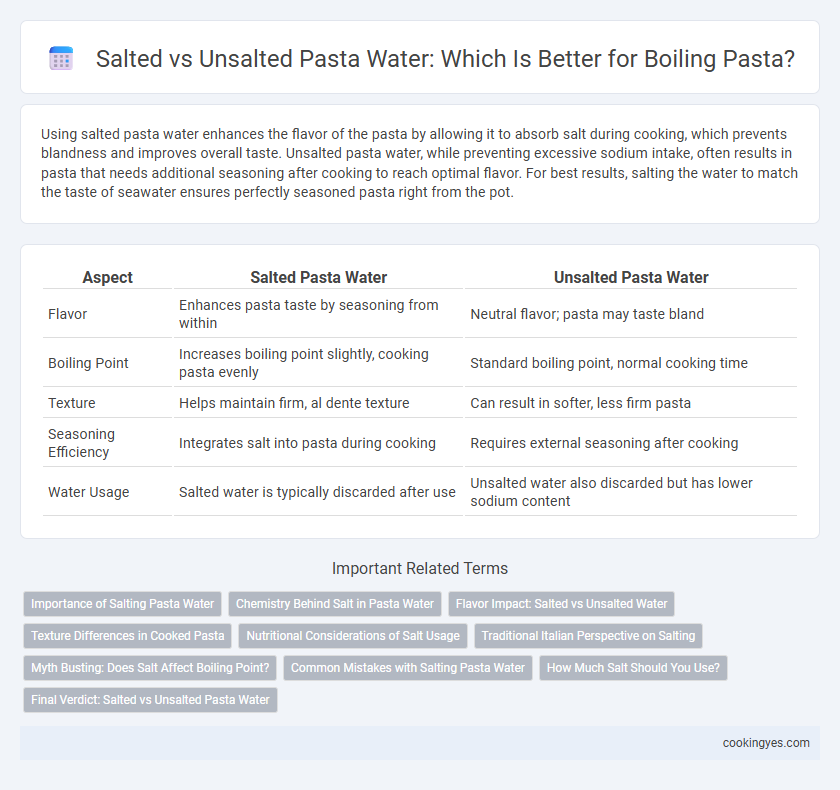Using salted pasta water enhances the flavor of the pasta by allowing it to absorb salt during cooking, which prevents blandness and improves overall taste. Unsalted pasta water, while preventing excessive sodium intake, often results in pasta that needs additional seasoning after cooking to reach optimal flavor. For best results, salting the water to match the taste of seawater ensures perfectly seasoned pasta right from the pot.
Table of Comparison
| Aspect | Salted Pasta Water | Unsalted Pasta Water |
|---|---|---|
| Flavor | Enhances pasta taste by seasoning from within | Neutral flavor; pasta may taste bland |
| Boiling Point | Increases boiling point slightly, cooking pasta evenly | Standard boiling point, normal cooking time |
| Texture | Helps maintain firm, al dente texture | Can result in softer, less firm pasta |
| Seasoning Efficiency | Integrates salt into pasta during cooking | Requires external seasoning after cooking |
| Water Usage | Salted water is typically discarded after use | Unsalted water also discarded but has lower sodium content |
Importance of Salting Pasta Water
Salting pasta water is crucial because it enhances the pasta's flavor by allowing the noodles to absorb seasoned water during cooking, resulting in a more balanced and well-seasoned dish. Unsalted pasta water can lead to bland pasta that requires excess seasoning later, which may disrupt the intended flavor profile of the sauce. The typical recommendation is to use about 1-2 tablespoons of salt per 4-6 quarts of water to achieve an optimal flavor that complements the pasta and sauce.
Chemistry Behind Salt in Pasta Water
Salted pasta water raises the boiling point through boiling point elevation, allowing pasta to cook at a slightly higher temperature, enhancing texture and preventing stickiness. Chemically, salt ions reduce the water activity, improving starch gelatinization, which helps pasta maintain firmness and absorb less water. Unsalted water lacks these ionic effects, leading to softer pasta with a tendency to clump and lose flavor during boiling.
Flavor Impact: Salted vs Unsalted Water
Boiling pasta in salted water enhances the pasta's natural flavor by allowing it to absorb the salt during cooking, resulting in a more seasoned and well-balanced taste. Unsalted water often leads to bland pasta that requires additional seasoning later, which can result in uneven flavor distribution. The optimal salt concentration in boiling water is approximately 1-2% by weight, mimicking seawater and maximizing flavor absorption.
Texture Differences in Cooked Pasta
Boiling pasta in salted water enhances the texture by slightly firming the starches on the surface, resulting in a chewier and more al dente bite. Unsalted pasta water tends to produce softer, less structured noodles due to the lack of ionic strength that influences gluten network formation during cooking. Salted water also helps maintain the pasta's shape, preventing it from becoming overly mushy or sticky.
Nutritional Considerations of Salt Usage
Boiling pasta in salted water increases sodium content, which can impact daily intake and cardiovascular health, especially for individuals monitoring salt consumption. Unsalted pasta water preserves the pasta's natural flavor and reduces sodium intake but may affect the seasoning absorption during cooking. Using moderate salt levels balances flavor enhancement with nutritional considerations while maintaining essential electrolyte balance.
Traditional Italian Perspective on Salting
Traditional Italian cooking emphasizes salting pasta water generously to enhance the pasta's natural flavor and ensure seasoning penetrates uniformly during boiling. Unsalted pasta water results in bland, under-seasoned pasta that relies heavily on sauce for taste, while salted water creates a balanced foundation that elevates the entire dish. This technique reflects the Italian culinary principle of layering flavors from the very beginning of the cooking process.
Myth Busting: Does Salt Affect Boiling Point?
Salted pasta water increases the water's boiling point slightly by about 0.5degC per 58 grams of salt per liter, but the amount of salt typically added for boiling pasta is too small to significantly alter the boiling temperature. The common belief that salt makes water boil much faster or slower is a myth; the main purpose of salting pasta water is to season the pasta and enhance flavor. Scientific studies confirm that the effect of salt on boiling point is negligible in culinary contexts, so cooking times remain virtually unchanged.
Common Mistakes with Salting Pasta Water
A frequent mistake when boiling pasta is under-salting the water, which results in bland noodles lacking flavor. Many cooks either skip adding salt or add it after the pasta is cooked, missing the chance for the pasta to absorb the seasoning during boiling. Properly salted pasta water should taste like the sea, typically requiring about 1-2 tablespoons of salt per 4-6 quarts of water for optimal flavor infusion.
How Much Salt Should You Use?
For boiling pasta, use about 1 to 1.5 tablespoons of salt per 4 quarts (16 cups) of water to achieve properly seasoned pasta. Salting the water not only enhances the pasta's flavor but also slightly raises the boiling point, improving cooking efficiency. Avoid under-salting, as pasta absorbs this salted water, making it the primary chance to infuse flavor before adding sauce.
Final Verdict: Salted vs Unsalted Pasta Water
Salted pasta water enhances the pasta's flavor by allowing it to absorb seasoning during cooking, preventing blandness in the final dish. Unsalted pasta water can result in a less flavorful base, requiring more seasoning after draining. For optimal taste and texture, using salted water is essential to achieving perfectly seasoned pasta from the start.
Salted pasta water vs Unsalted pasta water for boiling Infographic

 cookingyes.com
cookingyes.com